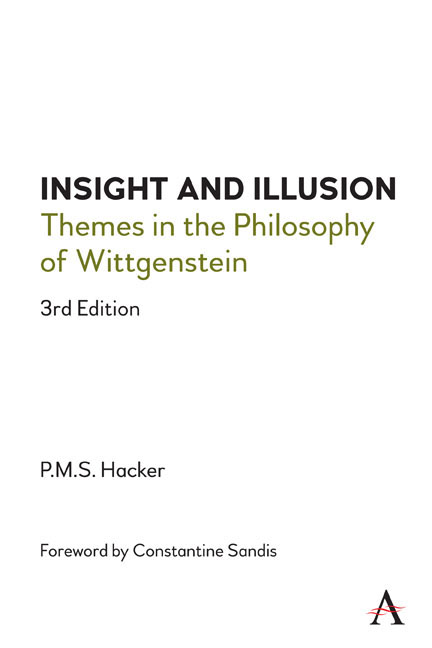Book contents
- Frontmatter
- Dedication
- Contents
- FOREWORD
- PREFACE TO THE REVISED EDITION
- PREFACE TO THE FIRST EDITION
- LIST OF ABBREVIATIONS
- I WITTGENSTEIN’S EARLY CONCEPTION OF PHILOSOPHY
- II THE DIALOGUE WITH FREGE AND RUSSELL
- III MEANING, METAPHYSICS, AND THE MIND
- IV EMPIRICAL REALISM AND TRANSCENDENTAL SOLIPSISM
- V DISINTEGRATION AND RECONSTRUCTION
- VI WITTGENSTEIN’S LATER CONCEPTION OF PHILOSOPHY
- VII METAPHYSICS AS THE SHADOW OF GRAMMAR
- VIII THE REFUTATION OF SOLIPSISM
- IX PRIVATE LINGUISTS AND PUBLIC SPEAKERS
- X ‘A CLOUD OF PHILOSOPHY CONDENSED INTO A DROP OF GRAMMAR’
- XI CRITERIA, REALISM AND ANTI-REALISM
- INDEX
PREFACE TO THE FIRST EDITION
Published online by Cambridge University Press: 24 February 2022
- Frontmatter
- Dedication
- Contents
- FOREWORD
- PREFACE TO THE REVISED EDITION
- PREFACE TO THE FIRST EDITION
- LIST OF ABBREVIATIONS
- I WITTGENSTEIN’S EARLY CONCEPTION OF PHILOSOPHY
- II THE DIALOGUE WITH FREGE AND RUSSELL
- III MEANING, METAPHYSICS, AND THE MIND
- IV EMPIRICAL REALISM AND TRANSCENDENTAL SOLIPSISM
- V DISINTEGRATION AND RECONSTRUCTION
- VI WITTGENSTEIN’S LATER CONCEPTION OF PHILOSOPHY
- VII METAPHYSICS AS THE SHADOW OF GRAMMAR
- VIII THE REFUTATION OF SOLIPSISM
- IX PRIVATE LINGUISTS AND PUBLIC SPEAKERS
- X ‘A CLOUD OF PHILOSOPHY CONDENSED INTO A DROP OF GRAMMAR’
- XI CRITERIA, REALISM AND ANTI-REALISM
- INDEX
Summary
The structure of this book can best be captured by means of a theatrical metaphor. The book has, as it were a central drama, a set, and a back-cloth. The subject with which I am primarily concerned, the drama which is enacted throughout the book, is Wittgenstein's metaphysics of experience. This Kantian term of art is chosen advisedly, for one of the leitmotifs consists in exploring the Kantian affinities of Wittgenstein's philosophy in general, both in the Tmctatusand in the post-1929 works. Wittgenstein's metaphysics of experience can be seen as consisting of a triad of problems, two of which are examined comprehensively. These are: self-consciousness, our knowledge of other minds, and our knowledge of objects. The secondary concern of the book, the set upon which the main drama takes place, is Wittgenstein's general conception of philosophy. This theme is intended to illuminate, and be illuminated by, the examination of Wittgenstein's metaphysics of experience. For the latter, particularly in Wittgenstein's later work, is an exemplification of his conception of the task, process, and result of philosophical investigation. As my work progressed, it became increasingly clear that the back-cloth against which the two main subjects had to be seen could not be wholly neglected. The back-cloth consists of the development of his semantic theories from the strict realism of the Tractatusto the constructivistinspired conventionalism of the Philosophical Investigations.I have explored this most difficult subject only so far as seemed to me necessary in order to grasp the nature of Wittgenstein's metaphysics of experience, his general contribution to epistemology, and his conception of philosophy. So the back-cloth is, as is customary in stage design, uneven. In parts it is filled in with colourful detail, at other points it is rough and ready.
Wittgenstein is almost unique among philosophers in having produced two complete philosophies, the later containing substantial criticism and repudiation of the earlier. The controversy over the degree of change and the degree of constancy will doubtless rage for many years to come. With respect to the subjects with which I am concerned in this book I have tried to plot both transformation and continuity. It is certainly impossible to understand Wittgenstein's later concern with and refutation of solipsism and idealism without seeing its roots in his fascination with Schopenhauer in the Notebooks 1914-16and the ‘methodological solipsism’ of the Philosophische Bemerkungen.
- Type
- Chapter
- Information
- Insight and IllusionThemes in the Philosophy of Wittgenstein, pp. xix - xxiiPublisher: Anthem PressPrint publication year: 2021

